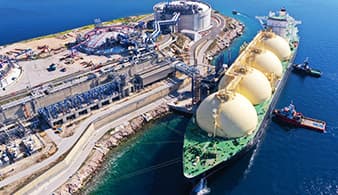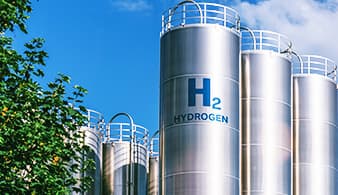Overview
Gas and power, two integral energy sources that underpin all major economic activities, are critical for businesses, which need access to reliable market information, data and prices. This enables them to make more informed decisions relating to their exposure to gas and power sectors.
Our team of market experts provides independent and reliable price assessments, indexes, market data and in-depth analysis. Our prices and market intelligence are used by energy companies, governments, banks, regulators, exchanges and many other organisations. You can benefit from our in-depth knowledge of these markets for better decision-making.
Gas and power market coverage
Argus is a leading independent provider of market intelligence to the global energy and commodity markets. Our price assessments and market intelligence are available for all major gas and power markets across the globe. Explore our coverage most relevant to your business.
Latest gas and power news
Browse the latest market-moving news on the global gas and power industry.
Australia needs electricity carbon policy: Commission
Australia needs electricity carbon policy: Commission
Sydney, 19 December (Argus) — The Australian government should introduce a national market-based policy to drive electricity sector decarbonisation, potentially modelled on the existing safeguard mechanism, economic research and advisory body the Productivity Commission (PC) said in a final report today. The PC had previously recommended applying the safeguard mechanism to electricity generators at the facility level, but it may be better to consider this issue separately, it noted in a final inquiry report into "investing in cheaper, cleaner energy and the net zero transformation". "Multiple policy options will need to be considered for the electricity sector, and even if a baseline-and-credit scheme is preferred, it may be better to keep this separate from the safeguard mechanism, at least at first, to avoid risks of uncertainty and disruption in the carbon credit markets that support that policy," the PC said. Currently there is little relationship between the emissions intensity of Australia's remaining coal-fired power plants and their announced retirement dates, according to the commission. Recognising the value of emissions reduction would pave the way for more emissions-intensive plants to retire earlier, it argued. Electricity excluded from safeguard mechanism Under the safeguard mechanism, facilities emitting more than 100,000t of CO2 equivalent (CO2e) in a compliance year across several sectors earn safeguard mechanism credits (SMCs) if they report scope 1 emissions below their baselines, and must surrender SMCs or Australian Carbon Credit Units (ACCUs) if their emissions are above the threshold. The electricity sector, Australia's largest emitter, is effectively excluded from the mechanism because the emissions reduction policy for the segment has been focused on renewable electricity targets. The mechanism applies a single sectoral baseline of 198mn t CO2e/yr across all electricity generators connected to Australia's main electricity grids, which is way above recent data — emissions from the electricity generation sector reached a combined 138.9mn t CO2e in the 2023-24 compliance year. A decision on whether to expand the mechanism to electricity may be considered in the upcoming safeguard mechanism review in 2026-27 . NEM review But any new policy will need to complement reforms arising from the National Electricity Market (NEM) review, which also received a final report this week . The decision will also need to be consistent with several policies and agreements already in place to support new investment or manage the exit of coal plants across Australia, the PC noted. While the existing Capacity Investment Scheme (CIS) and the proposed Electricity Services Entry Mechanism (ESEM) scheme mainly target renewable output or capacity, a least-cost emissions-reduction policy would help companies deciding when to retire coal and gas plants, according to the commission. This will be even more important if the Australian government prioritises firming auctions, which may support new gas-fired plants. Emissions policy uncertainty has been a major barrier to investment in gas-powered generation, the PC said. "Firming auctions will be more effective if project proponents know in advance how their emissions will be treated," it noted. Apart from a policy to drive electricity sector decarbonisation, the PC's final report urges the government to expand the safeguard mechanism , phase out fuel tax credits for on-road heavy vehicle operators, and reduce barriers to adopting low-emissions technology for heavy vehicles. And it also calls the government to phase out the fringe benefits tax exemption for electric vehicles (EVs), a recommendation that was criticised by industry body EV Council . By Juan Weik Send comments and request more information at feedback@argusmedia.com Copyright © 2025. Argus Media group . All rights reserved.
W Australia's gas surplus outlook strengthens: Aemo
W Australia's gas surplus outlook strengthens: Aemo
Sydney, 19 December (Argus) — The Australian Energy Market Operator (Aemo) is forecasting a bigger gas supply surplus in Western Australia (WA) for most of 2026-30, according to its 2025 WA Gas Statement of Opportunities (GSOO) report released today. Aemo now projects that both gas supply and demand will be lower than previously expected in the period, because of cutbacks at major industrial users and downward revisions to its production forecasts. But its demand revisions were larger than its supply revisions, increasing its projected surplus. The state's gas supply will exceed demand over most of that period, except in 2028 and 2030 (see table) . It has increased its projections for the size of the surplus compared with those in its 2024 WA GSOO report. Supply side Aemo cut its WA gas supply forecast because of delays, gas reserve depletions, and decreased expected production at the Gorgon, Scarborough, and Pluto projects, it said. The market operator previously expected Australia producer Strike Energy to open its 87 TJ/d (2.3mn m³/d) West Erregulla project in 2026. But Strike only aims to make a final investment decision on the project in July-December 2026 , later than originally anticipated . Strike's West Erregulla delay lowered WA's expected gas production by 52 TJ/d in 2027 and 63 TJ/d in 2028, Aemo said. Aemo has also cut its production expectations for the Scarborough and Pluto gas fields by up to 24 TJ/d in 2030, it said. Australian developer Woodside Energy aims to process 7mn t/yr of Scarborough gas and 3mn t/yr of Pluto gas from early 2027, it said in November. Workers building a 5mn t/yr LNG train at the Pluto LNG terminal plan to launch a strike on 6 January. Their current enterprise bargaining agreement with Australian engineering firm Bechtel will expire on 19 December, Argus understands. Planned maintenance and lower utilisation at the Gorgon project contributed to a 16 TJ/d cut to Aemo's forecasts, it said. The project's owners — which include Chevron, ExxonMobil, Shell, Osaka Gas, Tokyo Gas and Jera — will modify its three-train Gordon LNG terminal as part of a A$3bn ($1.98bn) project, it said in December. Reserve downgrades and depletions at the Walyering, Beharra Springs, Macedon, and Varanus Island fields mostly account for the rest of the supply revisions, Aemo said. The Walyering and Beharra Springs field reserve downgrades cut Aemo's WA supply forecast by 5 TJ/d in 2026 and 23 TJ/d in 2029, it added. Demand side The closure of nickel mining and alumina refining operations cut Aemo's 2026-30 demand forecast, the operator said. But demand will still rise over that period, from 1,085 TJ/d in 2026 to 1,295 TJ/d, because of new mining and processing activity, it said. US producer Alcoa opted to permanently close its 2.2mn t/yr Kwinana alumina refinery on 30 September , after it paused the site in July 2024. It has not announced a full closure timeline yet, Alcoa Australia president Elsabe Muller told Argus at the time. Australian miner IGO has also paused its Forrestania and Cosmos nickel projects over recent years. Multiple developers including Australian producers Iluka Resources , Cobalt Blue , and RZ Resources will develop critical mineral mining or processing projects in WA over the coming years. By Avinash Govind WA projected gas surplus TJ/d Year Surplus (2024 WA GSOO) Surplus (2025 WA GSOO) 2026 4 54 2027 5 20 2028 -12 -89 2029 5 132 2030 -2 -11 *GSOO refers to Gas Statement of Opportunities Source: Australian Energy Market Operator Send comments and request more information at feedback@argusmedia.com Copyright © 2025. Argus Media group . All rights reserved.
Viewpoint: Vietnamese pellet supply to remain volatile
Viewpoint: Vietnamese pellet supply to remain volatile
Singapore, 19 December (Argus) — The Vietnamese wood pellet market is likely to face supply volatility in early 2026 due to an adverse weather outlook in the coming months. This could be exacerbated by a busy period to clear shipments before the annual Tet holidays in February, while forecasts of rain in early 2026 could translate to a repetition of the supply shortages seen in 2025. Rain across the country can make it difficult to harvest raw material including wood chips, putting pressure on wood pellet production. La Nina weather conditions are expected to persist until February 2026 at a probability of 50-60pc, according to forecasts by the country's National Center for Hydro-Meteorological Forecasting (NCHMF). Areas in southern Vietnam are expected to have higher-than-average rainfall at 10-30mm from January-February 2026. Regions in northern and central Vietnam may receive significant rainfall at 15-35mm during the same period. The NCHMF expects the most rainfall in the Quang Tri region in central Vietnam, with forecasts of 50-150mm in January and 40-70mm of rain in February. Multiple typhoons hit the country in the second half of 2025. Rain and floods were also frequent during this period, damaging wood pellet stockpiles and causing delays to shipments. Significant volumes of wood pellets were damaged by floods in late November. This was akin to weather-related disruptions seen in 2024, which extended to the Tet holidays in 2025. The supply disruptions caused a significant backlog of shipments after the holidays. Vietnamese wood pellet production capacity is also set to increase in 2026, cushioning the impact of the shortage brought about by supply disruptions in the fourth quarter of 2025. More than 300,000 t/yr of additional wood pellets are expected to meet export demand by the end of 2026. A major wood pellet supplier plans to generate an additional 315,000 t/yr of capacity by the end of 2026. A Japanese energy company aims to build at least five new wood pellet factories in the coming years, of which one with a capacity of 150,000 t/yr capacity began operations in 2025. Wood pellet from alternative origins Wood pellets from origins such as Russia and Canada have historically been the main alternatives to Vietnamese pellets and are generally considered to be of better quality. South Korean annual imports from Canada and Russia in 2025 are projected to rise on the year, much like Canadian wood pellets to Japan. Japan stopped importing from Russia in 2022. South Korean and Japanese demand for wood pellets from other southeast Asian origins have also increased substantially in recent months, with new volumes coming from Indonesia and Malaysia. Imports from the two countries have risen in 2025, with Indonesia having seen the highest export growth this year among all regions. This trend is expected to continue into 2026 where South Korean state-owned utilities and independent power producers (IPPs) have awarded more tender volumes to non-Vietnamese sellers, while Japan is expecting more than 200MW of new generation capacity to come on line by the end of 2026. By Nadhir Mokhtar and Joshua Sim Send comments and request more information at feedback@argusmedia.com Copyright © 2025. Argus Media group . All rights reserved.
Energy Transfer halts plans for Lake Charles LNG
Energy Transfer halts plans for Lake Charles LNG
Houston, 18 December (Argus) — US midstream firm Energy Transfer is suspending development of its planned 16.5mn t/yr (2.2 Bcf/d) Lake Charles LNG export terminal in Louisiana to focus on natural gas pipeline expansions, the company said today. The pivot allows the company to reallocate capital to gas pipeline projects that provide "superior risk/return profiles", Energy Transfer said. The company separately said it will increase the capacity of its planned Desert Southwest expansion of the Transwestern pipeline, allowing it to move more gas from west Texas' Permian basin to the southwestern US. The decision to scrap Lake Charles LNG follows a month of dissonance from company executives about moving forward with the facility. Energy Transfer co-chief executive Mackie McCrea told investors in early November that the company would not be able to reach a final investment decision (FID) until it sold off 80pc of equity shares in the project. But Amy Chen Davis, vice president of Lake Charles LNG, told an industry event on 10 December that the company was in talks with potential partners and would reach a final decision in early 2026. The company said earlier this year it planned an FID by the end of 2025. The midstream firm has sought for years to convert the existing Lake Charles import facility into an export terminal. Shell signed on with a 50pc stake in 2019 but pulled out the following year as part of cost-cutting measures during the Covid-19 pandemic. McCrea had signaled to investors that the company was being cautious with entering the LNG export industry. "When you're chasing billions of dollars in projects, several of which we've already announced, we've got to be careful stepping out on something like this," McCrea said on 5 November. "We're not an LNG company like we compete with. We're a pipeline company that has a regas facility converting part of it to LNG." Investor MidOcean Energy had signed a preliminary agreement to fund 30pc of Lake Charles LNG's construction costs in exchange for 30pc of offtake, but the firms never finalized the deal. Suspension of the project also may set back the efforts of Saudi Aramco, which holds a 49pc stake in MidOcean, to develop an LNG portfolio. MidOcean has a share in Peru's 4.45mn t/yr Pampa Melchorita LNG export plant and the Shell-led 14mn t/yr LNG Canada export terminal in British Columbia. Pipeline project in focus Meanwhile, Energy Transfer said it will upsize capacity on the Desert Southwest expansion. The company said it will increase the expansion's capacity by 800mn cf/d to 2.3 Bcf/d to satisfy additional demand in the southwestern US. Energy Transfer reached an FID on Desert Southwest in August. The expansion is one of several projects working to increase gas transportation capacity out of the Permian, where a steady increase in crude-driven activity — and commensurate rise in associated gas output — has outpaced the increase in gas takeaway capacity. This has created a local gas supply glut and some of the lowest gas prices in the US. By Tray Swanson Send comments and request more information at feedback@argusmedia.com Copyright © 2025. Argus Media group . All rights reserved.
Spotlight content
Browse the latest thought leadership produced by our global team of experts.
Explore our gas and power products
Both the natural gas and power services have a long track record of providing well researched pricing, high quality analysis and market intelligence to our clients.
Key price assessments
Argus prices are recognised by the market as trusted and reliable indicators of the real market value. Explore some of our most widely used and relevant price assessments.













